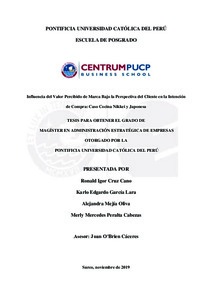Influencia del valor percibido de marca bajo la perspectiva del cliente en la intención de compra: caso cocina nikkei y japonesa

View/
Date
2020-01-28Author
Cruz Cano, Ronald Igor
García Lara, Karlo Edgardo
Mejía Oliva, Alejandra
Peralta Cabezas, Merly Mercedes
Metadata
Show full item recordAbstract
El objetivo principal de la presente investigación fue comprobar la influencia del valor
percibido de marca bajo la perspectiva del cliente en la intención de compra en restaurantes
de cocina nikkei y japonesa en Lima en el 2019. La investigación consideró el envío de
encuestas a una muestra no probabilística y por conveniencia de personas que han visitado
determinados restaurantes en los últimos seis meses y en un rango de edades determinados.
Obtenidos los resultados se realizó un análisis de confiabilidad mediante el enfoque
de consistencia interna usando el estadístico alfa de Cronbach. Para el análisis de hipótesis de
investigación en el modelo propuesto, se consideró la técnica del path analysis. El método de
estimación usado fue el de máxima verosimilitud. Con respecto a los índices de ajuste, se
están considerando el índice de ajuste comparativo (CFI, por sus siglas en inglés) y el error
cuadrático medio de aproximación (RMSEA, por sus siglas en inglés). El software utilizado
para el cálculo de los elementos de la matriz de correlaciones y de los coeficientes alfa fue el
IBM SPSS Statistics 25, mientras que para el path analysis se usó el IBM AMOS 25.
Los resultados obtenidos indican que todas las relaciones planteadas en este modelo
son estadísticamente significativas. Esto confirma la existencia de una relación positiva y
significativa entre el valor de marca para el consumidor y la intención de compra de comida
nikkei y japonesa. Queda definido que un valor de marca fuerte y positivo incrementará la
probabilidad de que se adquiera el producto. Estos resultados muestran la fuerte influencia de
la notoriedad de marca sobre las variables dependientes calidad percibida y asociaciones de
marca. De igual forma, en las relaciones existentes entre las asociaciones de marca y la
calidad percibida con lealtad de marca, se observa una mayor influencia de la primera. En
relación con el análisis, la intención de compra se encuentra explicada por las relaciones entre
las variables que componen el modelo, representadas por un 44%. The main objective of the present investigation was to verify the positive influence of
perceived brand value from the perspective of the client in the purchase intention in Nikkei
and Japanese restaurants in Lima in 2019. The investigation considered the sending of
surveys to a sample no probabilistic and for convenience of people who have visited certain
restaurants in the last six months and in a certain age range.
After the results are obtained, a reliability analysis is carried out using the internal
consistency approach using the Cronbach alpha statistic. For the analysis of research
hypotheses in the proposed model, the path analysis technique is considered. The estimation
method used was that of maximum likelihood. With respect to the adjustment indexes, the
comparative adjustment index (CFI) and the mean square error of approximation (RMSEA)
are being considered. The software used to calculate the elements of the correlation matrix
and the alpha coefficients was the IBM SPSS Statistics 25, while the IBM AMOS 25 was
used for the path analysis.
The results obtained indicate that all the relationships raised in this model are
statistically significant. This confirms the existence of a positive and significant relationship
between the brand value for the consumer and the intention to buy Nikkei and Japanese food.
It is defined that a strong and positive brand value will increase the likelihood of the product
being acquired. These results show the strong influence of brand awareness on the dependent
variables perceived quality and brand associations. Similarly, in the relationships between
brand associations and perceived quality with brand loyalty, there is a greater influence of the
former. In relation to the analysis, the purchase intention is explained by the relationships
between the variables that make up the model, represented by 44%.
Temas
Restaurantes--Perú
Comportamiento del consumidor
Comportamiento del consumidor
Para optar el título de
Maestro en Administración Estratégica de Empresas
Collections
The following license files are associated with this item:





